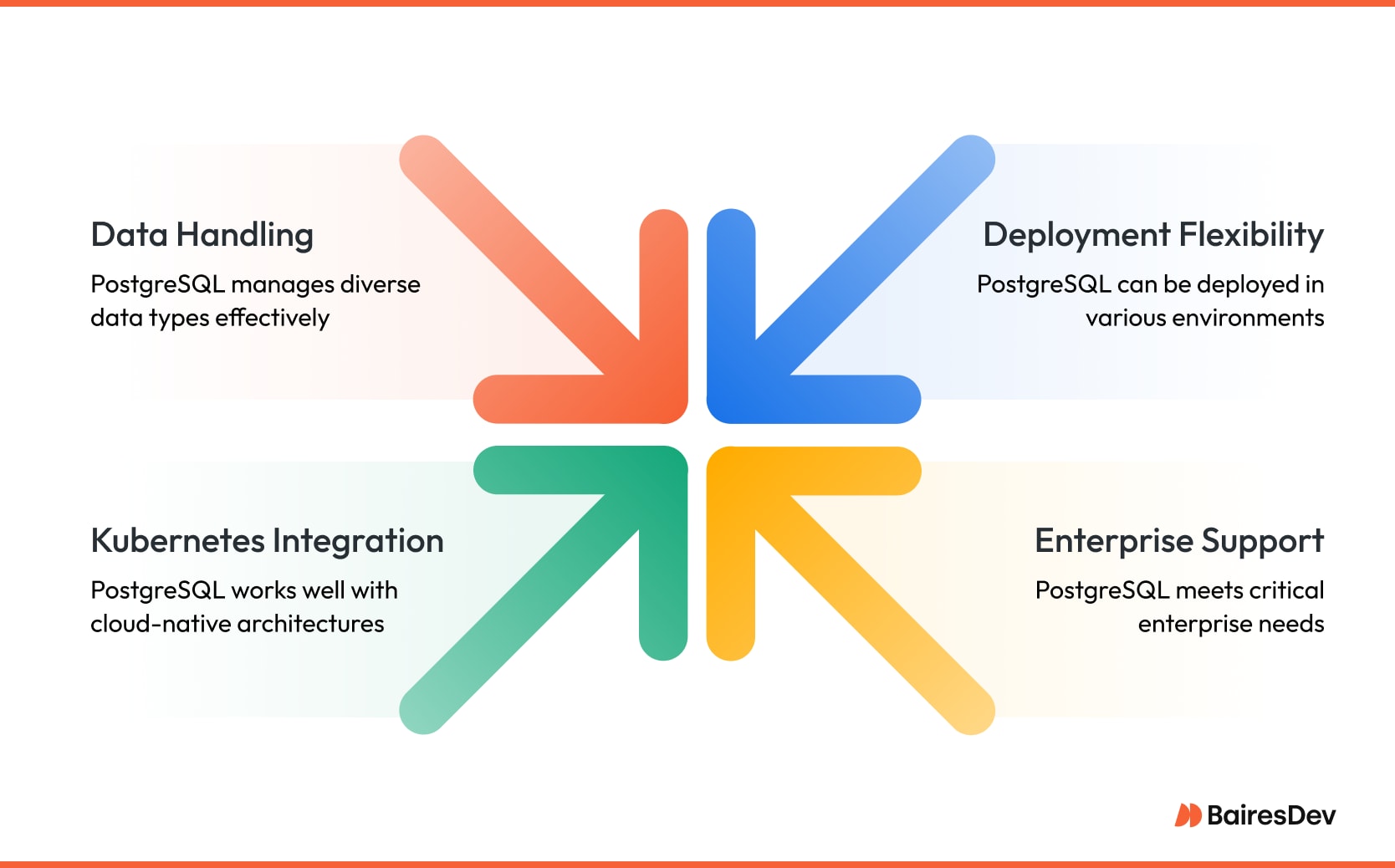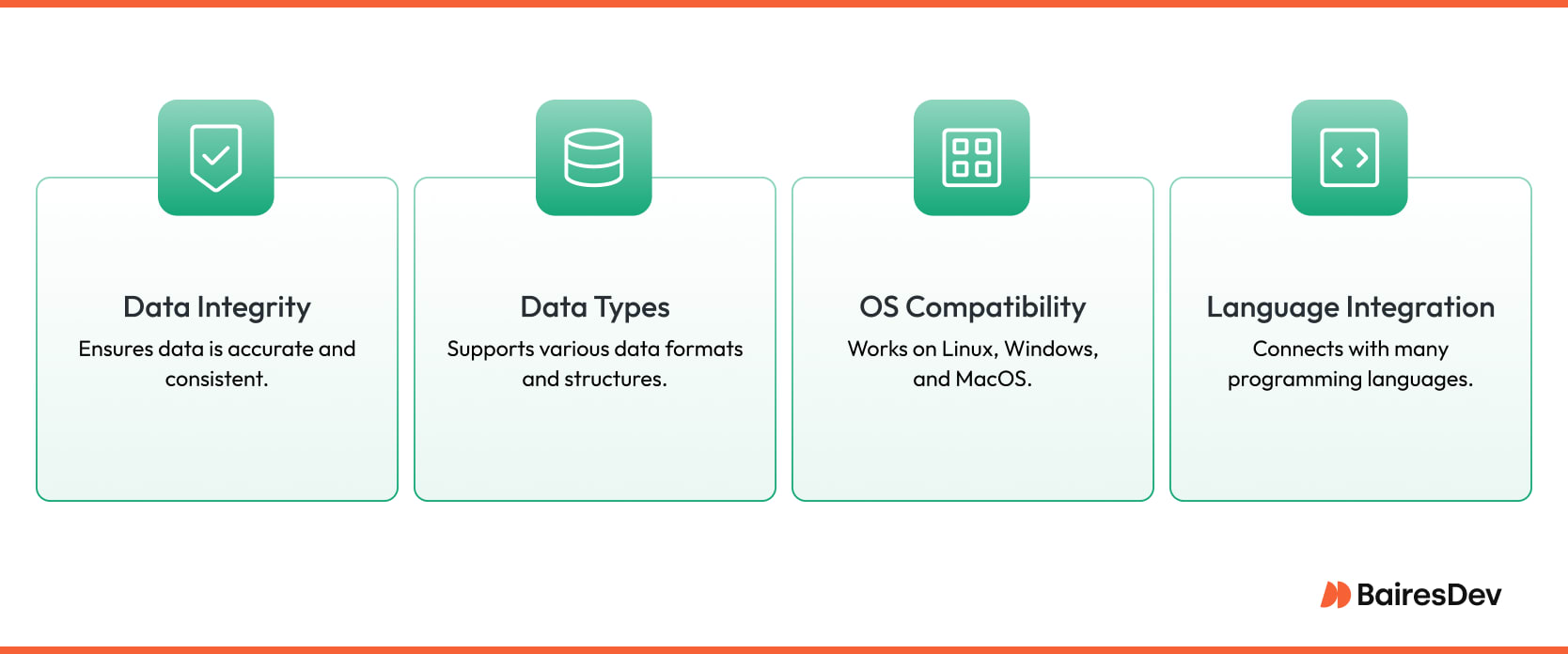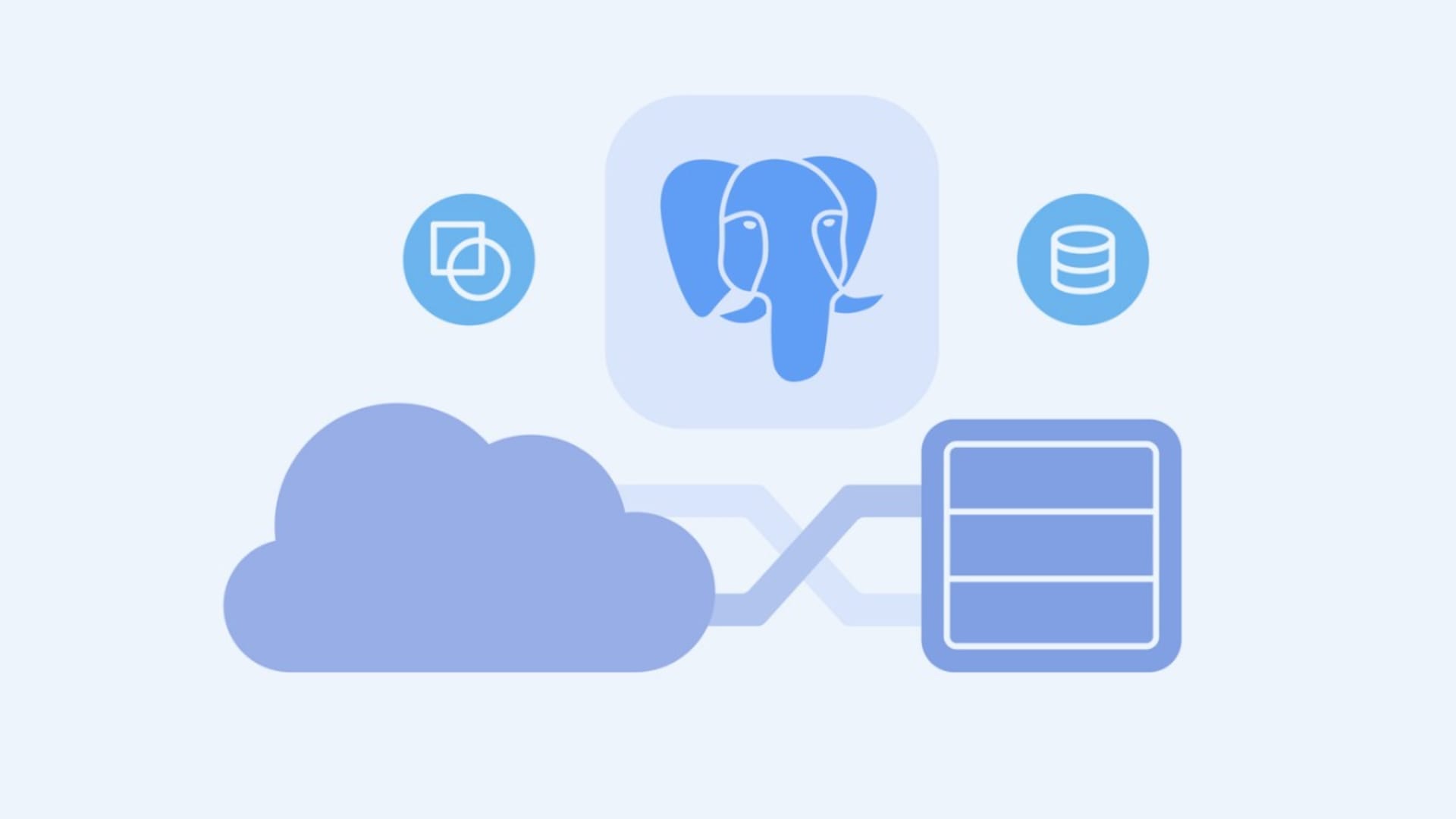When engineering leaders evaluate database solutions, they’re not just looking for a familiar name. They’re looking for a system that can handle complex queries, ensure data integrity, and scale with the needs of a fast-moving business.
PostgreSQL (often just called Postgres) is an open-source relational database management system built around the idea of being as SQL-compliant as possible. It is a highly extensible database, so it can be used for numerous applications, connected to nearly any type of API, and work on multiple platforms. The PostgreSQL Global Development Group is the primary entity responsible for the development and maintenance of PostgreSQL, supported by an extensive community that contributes additional features typically associated with proprietary software.
PostgreSQL started as the successor to the Ingres database, which was developed at the University of California, at Berkeley. In 1996 the project officially took on the name PostgreSQL and has been in active development since.
Being a relational database management system, PostgreSQL can help power any number of applications and services. And like some of the competition (such as MySQL), PostgreSQL can not only be deployed on Linux but also on macOS and Windows.
For engineering teams, the appeal is clear: PostgreSQL is not just another database system. It’s an adaptable, open source relational database solution that supports advanced use cases, integrates with modern application stacks, and offers the freedom to innovate without the lock-in of proprietary databases.
What Makes Relational Databases Appealing to Businesses
A relational database organizes data into structured tables with defined relationships. This architecture allows organizations to analyze data across related tables, enforce data integrity, and run complex queries that pull insights from multiple sources.
In modern enterprise environments, the choice of a relational database is not just about the data model. It dictates the way the system supports extensibility, scalability, and integration. PostgreSQL excels here because it offers features like multi-version concurrency control (MVCC), granular access controls, asynchronous replication, point-in-time recovery, and a rich ecosystem of procedural languages and custom functions.
These aren’t just technical bells and whistles. They are essential tools for engineering leaders managing distributed systems, scaling cloud-native architectures, or supporting data-intensive application development. With PostgreSQL, businesses get an open-source license, active community, and enterprise-grade features that rival (and sometimes even outperform) other database management systems, all while maintaining the flexibility to customize and extend the system for unique business needs.
Features of PostgreSQL, Including Stored Procedures
PostgreSQL includes several important features, sure to check the boxes for many database administrators.

At its core, PostgreSQL is a SQL-compliant relational database that supports just about everything you’d expect:
- Strong data integrity
- Support for a wide range of data types
- Compatibility across operating systems like Linux, Windows, and macOS
- Integration with many programming languages
But what really makes it stand out?
For one, it’s designed to handle complex queries and large numbers of concurrent users. Thanks to features like multi-version concurrency control (MVCC), it can process multiple transactions at once without locking things up or causing conflicts — something that’s critical when you’re working at scale.
It also supports stored procedures, which let you bundle up several operations into a single call. That’s useful when you want to push logic down into the database and cut down on unnecessary back-and-forth between the app and the data layer.
Another key strength is extensibility. PostgreSQL allows you to define custom data types and functions, or even add new procedural languages. This flexibility makes it easier to model data the way you need, instead of twisting your application around the database’s limits.
When it comes to replication, PostgreSQL supports synchronous, asynchronous, and logical replication out of the box. That gives you options for scaling out, adding read replicas, or setting up high-availability architectures, depending on what your system requires.
And let’s not overlook security. PostgreSQL offers granular access controls, data encryption, and a variety of authentication methods. For teams handling sensitive or regulated data, those features aren’t optional — they’re table stakes.
Finally, PostgreSQL integrates well with a range of tools. Whether you prefer working from the command line, using GUIs like pgAdmin, or pulling data into analytics platforms, the ecosystem has grown to support a wide variety of workflows.
Put simply, PostgreSQL offers the flexibility and control that engineering teams need when they’re working on projects that can’t afford to break.
Programming Languages and PostgreSQL: What Integrates Best?
When it comes to integrating PostgreSQL into enterprise systems, the real question isn’t “what languages work with it?” — it’s how well those integrations perform, and how easily your teams can use the database across diverse stacks.
PostgreSQL has a long history of strong multi-language support. Out of the box, it connects smoothly with popular programming languages like .NET, Java, Python, PHP, C++, Ruby, Perl, Go, JavaScript via Node.js, and many others. This wide compatibility is a key reason why many enterprises choose PostgreSQL: they can adopt it without forcing a change to their existing application frameworks.
For backend developers, PostgreSQL provides mature, well-maintained drivers and libraries (like JDBC for Java, psycopg for Python, Npgsql for .NET, and pg-promise for Node.js), making it straightforward to incorporate database operations into application logic. These connectors are actively developed and optimized, which helps reduce common integration headaches.
PostgreSQL’s extensibility also means teams can embed procedural languages directly into the database, such as PL/pgSQL, PL/Python, PL/Perl, or PL/Java, allowing certain logic to run close to the data. This can improve performance for workloads that benefit from stored procedures, custom functions, or specialized triggers.
In short, no matter what stack your organization is working with, PostgreSQL can integrate cleanly, offering both flexibility and stability for cross-language development.
Where PostgreSQL Fits in Today’s Database Landscape
One of the biggest reasons PostgreSQL continues to hold ground in the enterprise world is its flexibility. You can run it almost anywhere — on a server in your own data center, in the cloud, in a hybrid setup, or inside a containerized environment. But for engineering leaders, the more interesting question isn’t just “where can it run?” — it’s what do those choices mean for performance, scalability, and day-to-day operations.

If you’re running on-prem, PostgreSQL gives you fine-grained control over performance, storage, and networking. This is often important for organizations dealing with sensitive data or working under strict compliance requirements. On-prem setups may sound old-school, but they offer predictability, especially when you need to meet tough SLAs without dealing with the complexities of public cloud.
On the other hand, PostgreSQL works exceptionally well in the cloud. Managed services like Amazon RDS for PostgreSQL, Google Cloud SQL, and Azure Database for PostgreSQL take a lot of the operational heavy lifting off your plate. Instead of worrying about backups, patching, and failovers, your team can focus on higher-value work — like improving applications and evolving your data strategy. And if you need to move fast, cloud deployments give you the ability to scale out horizontally, spin up read replicas, or replicate across regions with just a few clicks.
For teams working in containerized or Kubernetes-based environments, PostgreSQL fits right in. With tools like the Crunchy PostgreSQL Operator or Zalando’s Postgres Operator, you can manage dynamic scaling, automated failover, and rolling upgrades — all in line with modern DevOps workflows. This is especially useful if you’re aiming for a cloud-native architecture without sacrificing the stability you expect from a mature database system.
It’s also worth mentioning that PostgreSQL isn’t just about traditional relational data. With the PostGIS extension, it becomes a powerful engine for geospatial data, supporting advanced GIS use cases and location-based services. And thanks to its ability to work with semi-structured formats like JSON and XML, it’s a strong choice for applications that need to combine classic relational data with more flexible document models.
In the end, PostgreSQL’s strength across environments isn’t just a nice-to-have feature — it’s a strategic asset. It gives engineering teams the freedom to design systems based on business needs, not database limitations.
PostgreSQL Tools That Matter
Running PostgreSQL in an enterprise setting goes far beyond just writing queries. It takes a well-rounded set of tools to keep systems healthy, performant, and secure — especially when you’re dealing with complex workloads or distributed environments.
For database management, pgAdmin remains one of the most widely used interfaces. Available as both a web app and a desktop tool, it gives DBAs and developers an easy way to manage databases, run queries, monitor activity, and visualize performance metrics without living inside the command line. Some teams also use phpPgAdmin for similar web-based administration, though it’s somewhat less common these days.
When it comes to performance monitoring, tools like PgFouine and pgBadger can be invaluable. They dig into PostgreSQL’s logs, highlight slow queries, and offer insights into where the system is spending time. For teams that need more real-time visibility or want to integrate database monitoring with their broader observability stack, Prometheus and Grafana pair nicely with PostgreSQL, providing live dashboards and customizable alerts.
In DevOps-heavy environments, Kubernetes-native tools like the Crunchy PostgreSQL Operator and Zalando’s Postgres Operator help manage PostgreSQL clusters. They handle things like scaling, failover, backups, and upgrades — all through infrastructure-as-code workflows that mesh with CI/CD pipelines. This makes it much easier to run PostgreSQL in containerized, cloud-native setups without introducing brittle manual processes.
For backup and recovery, many enterprises lean on tools like Barman and pgBackRest. Both support automated backups, point-in-time recovery, and WAL (write-ahead logging) management, helping teams build resilient, recoverable systems that can withstand failures or data corruption events.
Finally, on the security side, pgaudit offers detailed audit logging for organizations that need to meet compliance or regulatory requirements. Combined with PostgreSQL’s built-in SSL/TLS support, role-based access control, and advanced authentication, these tools help teams lock down sensitive data while maintaining flexibility.
Security and Reliability
PostgreSQL is designed with a strong focus on security and reliability, making it suitable for mission-critical applications. It supports various authentication and authorization mechanisms, including password authentication, SSL/TLS encryption, and role-based access control, ensuring that only authorized users can access the data.
PostgreSQL also provides robust features for ensuring data integrity, such as transactional support, locking, and multi-version concurrency control (MVCC). These features help maintain data consistency and prevent conflicts during concurrent data access. Additionally, PostgreSQL offers a range of tools for monitoring and maintaining database performance, including logging, auditing, and backup and recovery options. These capabilities ensure that PostgreSQL databases remain secure, reliable, and performant.
The Competitive Advantages of Using PostgreSQL
For engineering leaders evaluating database options, PostgreSQL offers a combination of technical strength, flexibility, and operational efficiency that’s hard to match — especially when compared to proprietary systems like Oracle, Microsoft SQL Server, or even open-source peers like MySQL and MongoDB.
Here’s what makes PostgreSQL particularly valuable at the enterprise level:
- True extensibility and adaptability
PostgreSQL doesn’t lock you into rigid patterns. Thanks to its extensible design, teams can define custom data types, write stored procedures, or embed business logic directly in the database using multiple procedural languages. This reduces the need to twist application code around database limitations and allows solutions to be shaped around actual business needs. - Multi-version concurrency control (MVCC)
One of PostgreSQL’s core strengths is its MVCC system, which allows multiple transactions to run concurrently without locking the entire database. This is a major performance and stability advantage for systems with heavy read/write workloads or applications requiring consistent availability under load. - Operational simplicity and lower maintenance overhead
While no production-grade database is truly “low maintenance,” PostgreSQL’s design is known for its stability and predictability. With the right monitoring and backup strategies, teams can run PostgreSQL in production for years without constant firefighting — a stark contrast to more brittle or license-heavy systems. - Open-source freedom with a strong ecosystem
PostgreSQL’s open-source license gives organizations full access to the source code, allowing for customization, optimization, and deep integrations. But equally important is the surrounding ecosystem: an active global community, a rich set of tools, and commercial vendors offering paid support or specialized distributions when needed. This combination lets teams tailor their level of support without being locked into a single proprietary vendor. - Cross-environment consistency
Whether you’re running PostgreSQL on bare metal, in virtual machines, on Kubernetes, or through a managed cloud service, you’re working with the same database engine. This consistency makes it easier to design hybrid and multi-cloud architectures without worrying about shifting underlying behaviors between environments. - Cost-effectiveness at scale
Compared to commercial database systems with expensive per-core or per-instance licenses, PostgreSQL’s open-source model can deliver significant cost savings, especially as workloads grow. This allows engineering and product teams to scale aggressively without facing steep license penalties or vendor lock-in.
Versions of PostgreSQL
PostgreSQL is developed as a single open-source project, with no official split between different editions. No matter where you deploy, you’ll be working with the same PostgreSQL engine.
That said, the ecosystem offers additional options. Some companies provide commercial distributions with enhanced tooling and enterprise support, while cloud providers like AWS, Azure, and Google Cloud offer fully managed PostgreSQL services with their own operational models.
Industry-Specific Use Cases
PostgreSQL is widely used across various industries due to its versatility and robust feature set.
In the finance industry, PostgreSQL is employed for online transaction processing, data warehousing, and business intelligence, providing reliable and efficient data management solutions. In healthcare, PostgreSQL is used to store and manage patient data, medical records, and research data, ensuring data integrity and accessibility. Government agencies use PostgreSQL to manage public records, voter rolls, and administrative databases. Universities use PostgreSQL to store and manage student data, course schedules, and academic records.
These industry-specific use cases highlight PostgreSQL’s adaptability and effectiveness in managing a wide range of data-driven applications.
Conclusion
Choosing the right database isn’t just a technical decision. It’s a long-term strategic commitment.
PostgreSQL offers a rare combination of the flexibility of an open-source relational database, paired with the performance, reliability, and extensibility needed for large-scale applications. Backed by a mature ecosystem, an active development community, and a proven track record, Postgres enables engineering leaders to innovate confidently, without locking teams into expensive proprietary solutions.
For engineering leaders balancing cost, scale, and long-term adaptability, PostgreSQL remains one of the most practical and resilient database choices available.






